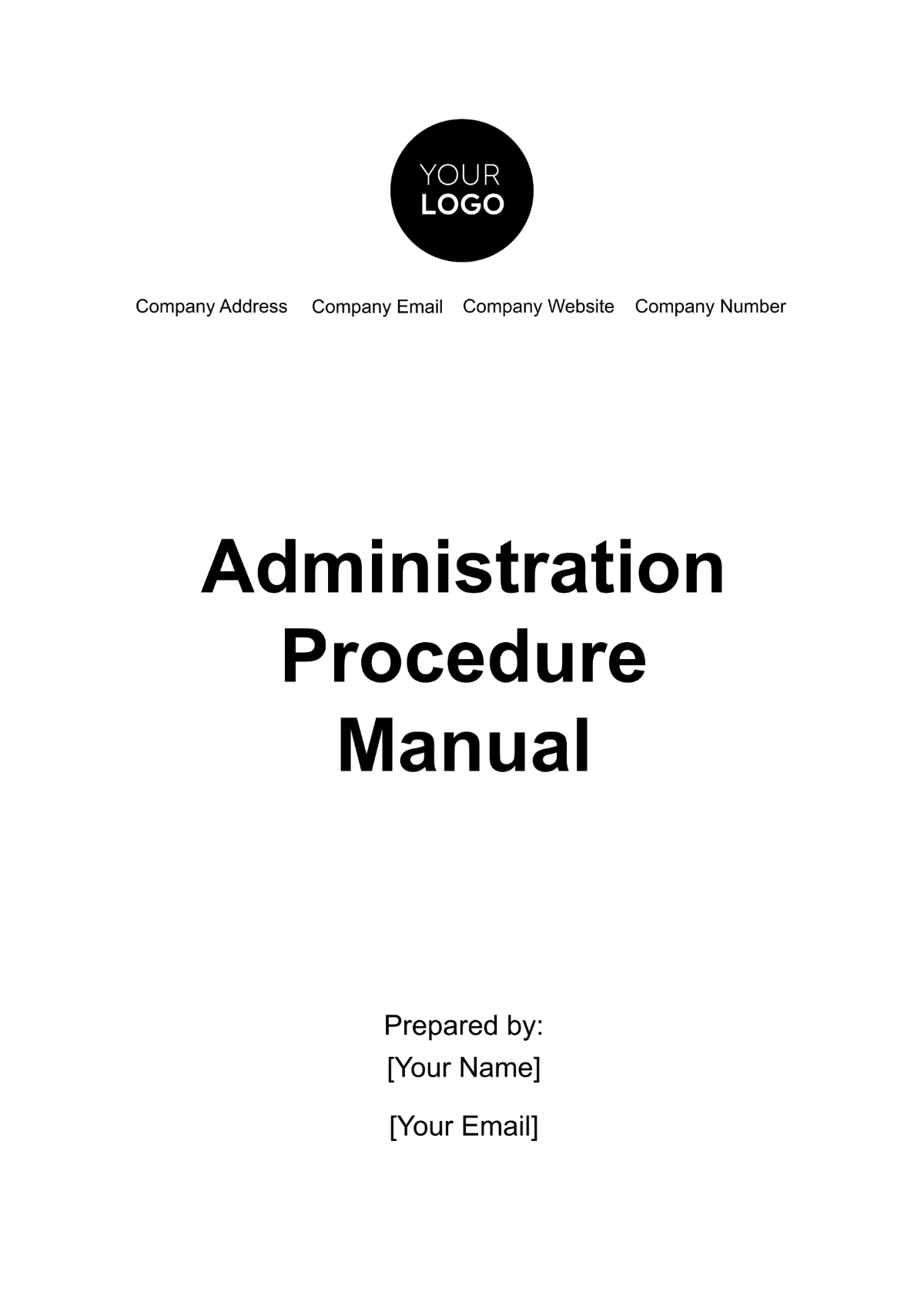Introduction
At [Your Company Name], the importance of conducting all financial activities with the utmost efficiency, transparency, and adherence to regulatory compliance cannot be overstated. This manual is crafted to serve as a comprehensive guide for all employees, delineating the specific procedures and responsibilities allocated across various financial operations.
Overview of Financial Procedure
The financial procedures encapsulated herein detail the systematic approach required for the execution, verification, and oversight of all financial transactions. This framework is designed to foster transparency and accountability within our financial ecosystem, thereby safeguarding the organization and its assets against potential risks and ensuring the integrity of our financial practices.
Responsibilities and Roles
This section of the manual is dedicated to elucidating the specific roles and responsibilities inherent to the financial operations within [Your Company Name]. It aims to establish clear expectations and accountability for all employees engaged in financial transactions and processes, ensuring the seamless execution and oversight of the company's fiscal activities.
Executive Management:
Ultimate Oversight: Holds ultimate responsibility for overseeing financial policies and procedures, ensuring they align with the company's strategic vision and operational requirements
Financial Decision-Making: Authorizes significant financial decisions and strategies, guiding the company towards sustainable growth and financial stability.
Regulatory and Ethical Compliance: Guarantees that the organization's financial practices adhere to legal regulations and uphold the highest ethical standards, fostering trust and integrity within and outside the company.
Finance Department:
Operational Management: Manages day-to-day financial operations, encompassing accounting, budgeting, and financial reporting, ensuring accuracy and efficiency in financial transactions.
Controls and Procedures: Implements robust financial controls and procedures to safeguard assets, manage risks, and enhance financial performance.
Strategic Financial Reporting: Prepares financial statements and compliance documents, conducting regular audits and financial analysis to inform strategic decision-making and ensure regulatory compliance.
Human Resources (HR):
Payroll Management: Oversees payroll processes, ensuring employees receive accurate and timely payments, reflecting the organization's commitment to its workforce.
Benefits Administration: Manages employee benefits and compensation schemes in accordance with financial policies, ensuring equitable and competitive compensation practices.
Financial Collaboration: Works closely with the Finance Department to integrate HR financial operations with the company's broader financial management strategies, enhancing organizational coherence and fiscal responsibility.
Procurement Team:
Cost-Effective Procurement: Manages procurement activities to ensure cost-effectiveness and compliance with the company’s procurement policies, optimizing resource allocation.
Vendor Management: Performs thorough vendor evaluations and negotiations to secure maximum value and minimize financial risks, contributing to the company's competitive advantage.
Financial Integration: Collaborates with the Finance Department to ensure procurement activities are accurately reflected in the budget and financial accounts, maintaining fiscal accuracy and integrity.
All Employees:
Policy Adherence: Complies with established financial policies and procedures, recognizing the role of individual responsibility in the financial health of the organization.
Expense Reporting: Ensures timely and accurate reporting of expenses, adhering to budgetary constraints and financial guidelines, fostering a culture of transparency and accountability.
Vigilance and Reporting: Assumes responsibility for reporting any financial discrepancies or concerns to management, contributing to an environment of trust and proactive financial governance.
This delineation of roles and responsibilities is designed to foster a culture of accountability and precision in the management of [Your Company Name]'s financial resources. It is imperative that all employees are familiar with their respective duties and the overarching financial protocols to uphold the integrity and efficiency of our financial operations.
Budget Planning and Approval
The budget planning and approval process at [Your Company Name] is a critical component of our financial management framework. It ensures that all financial resources are allocated efficiently and in alignment with our strategic objectives. This section outlines the structured approach to developing, reviewing, and approving the organization's budget, emphasizing collaboration, transparency, and fiscal responsibility.
Process Overview:
Budget Proposal: Each department meticulously prepares and submits their budget proposals for the forthcoming fiscal year. These proposals include detailed projections of anticipated expenses along with comprehensive justifications, ensuring that all requests are aligned with departmental goals and strategic objectives.
Review and Adjustment: Upon receipt of the budget proposals, the Finance Department conducts a thorough review of all submissions. This phase involves close collaboration with individual departments to refine estimates and ensure that proposed budgets are not only realistic but also align with the organization's overarching strategic priorities. The aim is to optimize resource allocation across the company.
Preliminary Approval: Following the review and refinement stage, a consolidated budget summary is prepared and presented to the executive management team. This presentation serves as a platform for preliminary approval, facilitating a dialogue on potential adjustments and reallocations to address strategic concerns and operational necessities.
Final Approval: After incorporating feedback from executive management, the revised budget is escalated to the Board of Directors for final examination and approval. This crucial step ensures that the budget reflects both the strategic vision of the organization and its financial constraints, securing the endorsement of the highest governing body.
Implementation and Monitoring: With the budget formally approved, the focus shifts to implementation and rigorous monitoring throughout the fiscal year. This entails tracking budget execution against planned expenditures, ensuring adherence to approved allocations, and making adjustments as necessary to address unforeseen financial variances or shifts in strategic direction. Regular reporting and analysis support proactive financial management and ensure fiscal discipline.
Performance Evaluation: This additional phase involves the evaluation of financial performance against the budgeted projections. Departments are assessed on their budgetary discipline and the efficiency of their financial management.
Feedback and Future Planning: In the final stage, feedback from the budget implementation and performance evaluation phases is gathered and analyzed. This critical insight informs future budget planning, allowing the organization to refine its financial strategies and enhance its budgetary processes for subsequent fiscal years.
Budget Approval Table:
The following table illustrates the key stages in the budget planning and approval process, including the responsible parties and expected timeframes.
Stage | Responsible Party | Expected Timeframe |
|---|---|---|
Budget Proposal Submission | All Departments | [Month Day, Year] - [Month Day, Year] |
This structured approach to budget planning and approval is designed to ensure that [Your Company Name] allocates its financial resources effectively, supporting our mission and strategic goals while maintaining financial stability and compliance. It is imperative that all departments adhere to the outlined timelines and processes to facilitate a smooth and efficient budgeting cycle.
Invoicing and Payment Process
The Invoicing and Payment Process at [Your Company Name] is designed to uphold the highest standards of accuracy, transparency, and efficiency in managing financial transactions. This comprehensive process encompasses the systematic creation, issuance, and diligent tracking of invoices, coupled with the meticulous reconciliation of incoming payments. It serves as a cornerstone in our financial operations, ensuring that every transaction aligns with our commitment to fiscal responsibility and operational excellence.
Process Steps:
Invoice Creation: Upon the completion of a service or the delivery of goods, the responsible department generates an invoice detailing the services rendered, goods provided, quantities, prices, and total charges. This step involves the careful verification of contractual terms and conditions to ensure billing accuracy.
Invoice Issuance: The invoice is then reviewed for accuracy and completeness before being issued to the client or customer. This issuance process is supported by our digital accounting systems, which facilitate prompt and accurate delivery through electronic means, ensuring a traceable and efficient communication flow.
Payment Tracking and Follow-Up: Once the invoice is issued, it is entered into our financial tracking system, which monitors due dates and payment statuses. Regular follow-ups are conducted for overdue payments, employing a structured approach that includes reminder notices and direct communication to resolve any discrepancies or delays.
Payment Receipt and Reconciliation: Upon receipt of payment, it is crucial to match each payment against its corresponding invoice to ensure that amounts paid are correct and account for any partial payments or adjustments. This reconciliation process is vital for maintaining accurate financial records and providing clear visibility into the company’s cash flow.
Reporting and Analysis: The Finance Department conducts regular analyses of invoicing and payment patterns, identifying trends, and any areas for improvement. This ongoing review helps to streamline the process, enhance customer satisfaction, and optimize the company's financial health.
By adhering to this detailed Invoicing and Payment Process, [Your Company Name] ensures that all financial transactions are executed with precision and integrity. This not only secures the company's revenue stream but also fortifies trust with our clients and partners through consistent and professional financial management practices.
Administration of Petty Cash
The Administration of Petty Cash plays a vital role in facilitating the efficient handling of minor and incidental expenses that arise in the course of day-to-day operations. This system is meticulously managed to ensure accessibility, accountability, and security, providing a streamlined process for the disbursement and replenishment of petty cash funds. The process is governed by strict guidelines to prevent misuse and to maintain accurate financial records.
Key Components of Petty Cash Management:
Petty Cash Fund Establishment: A predetermined amount is set aside to establish the petty cash fund, based on historical needs and anticipated expenditures.
Disbursement: Funds are disbursed from the petty cash for approved expenses, with all disbursements requiring receipts or detailed expense reports for documentation and future reconciliation.
Reconciliation and Replenishment: The petty cash custodian regularly reconciles the fund, comparing the cash on hand plus receipts to the initial fund balance. Replenishment requests are then submitted to restore the fund to its designated level.
Security and Storage: The petty cash is securely stored in a lockable cash box or drawer, with access limited to the appointed custodian or authorized personnel.
Audit and Review: Periodic audits are conducted to ensure compliance with petty cash policies, verify the accuracy of transactions, and assess the efficiency of the process.
Petty Cash Management Table:
The following table outlines the responsibilities and procedural steps for the effective administration of the petty cash system:
Step | Responsibility | Procedure |
|---|---|---|
Establishment of Petty Cash | Finance Department | Determine fund size, approve setup, and allocate initial funds. |
This structured approach to the administration of petty cash ensures that [Your Company Name] efficiently manages these funds with the highest level of integrity and accountability. It enables the company to handle small, routine expenses in a manner that is both convenient and financially responsible, while also maintaining comprehensive oversight to safeguard against financial discrepancies.
Annual Auditing Process
The Annual Auditing Process at [Your Company Name] is an essential mechanism designed to uphold and enhance the economic integrity and transparency of our financial operations. This rigorous process encompasses a comprehensive evaluation of our financial statements, a thorough assessment of our internal control mechanisms, and an in-depth analysis of the overall financial health of the company. By systematically examining these components, the audit ensures the accuracy of our financial reporting, the effectiveness of our financial controls, and the robustness of our financial management practices.
Core Elements of the Annual Auditing Process:
Preparation and Planning: This initial phase involves gathering all necessary financial documents, including previous years' audits, financial statements, and records of transactions. The Finance Department collaborates with the appointed auditors to establish a clear audit timeline and objectives.
Evaluation of Financial Statements: Auditors conduct a detailed review of the company's financial statements to verify their accuracy and consistency with generally accepted accounting principles (GAAP). This includes an analysis of balance sheets, income statements, cash flow statements, and notes to the financial statements.
Assessment of Internal Controls: A critical examination of the company's internal controls over financial reporting is performed to identify any weaknesses or areas for improvement. This assessment ensures that the company has effective mechanisms in place to prevent errors, fraud, and financial misstatement.
Testing and Verification: Through a series of tests, auditors validate the integrity of financial transactions and the reliability of financial data. This may involve sampling transactions, verifying documentation, and testing compliance with internal policies and external regulations.
Report and Recommendations: Upon completion of the audit, a comprehensive report is prepared, highlighting the findings, areas of concern, and recommendations for improvement. This report is presented to executive management and the Board of Directors, providing them with an objective assessment of the company's financial status and control environment.
Implementation of Improvements: Based on the audit findings, the company commits to addressing identified deficiencies and implementing recommended improvements. This may involve revising financial policies, enhancing internal controls, or taking corrective actions to rectify any discrepancies.
Annual Auditing Timeline Table:
The table below outlines the typical timeline and key milestones of the Annual Auditing Process:
Phase | Key Activities | Estimated Timeframe |
|---|---|---|
Preparation and Planning | Gather financial documents, establish audit objectives. | [Month Day, Year] - [Month Day, Year] |
The Annual Auditing Process is integral to maintaining the fiscal discipline and accountability that [Your Company Name] stands for. It not only reassures stakeholders of the company's financial integrity but also lays a foundation for continuous improvement and strategic financial management.
Contact
For additional information or queries regarding this manual and our financial procedures, we encourage you to reach out to us directly. Our dedicated team is available to provide you with the assistance and clarity you require.
Please feel free to contact us via email at [Your Company Email] or by telephone at [Your Company Number]. We are committed to ensuring that your questions are answered promptly and thoroughly, and we look forward to assisting you with any concerns or needs you may have.
Conclusion
This manual has been designed to serve as a guide for the management of financial procedures at [Your Company Name]. It outlines the principles, processes, and practices that underpin our commitment to financial integrity, transparency, and accountability. By adhering to the guidelines and protocols detailed herein, we ensure the effective and efficient management of our financial resources, safeguarding the company's assets and interests.
We encourage all staff members to familiarize themselves with the contents of this manual and to apply its directives in their respective roles. Together, we can achieve and maintain the highest standards of financial excellence that our stakeholders expect and deserve.

















































